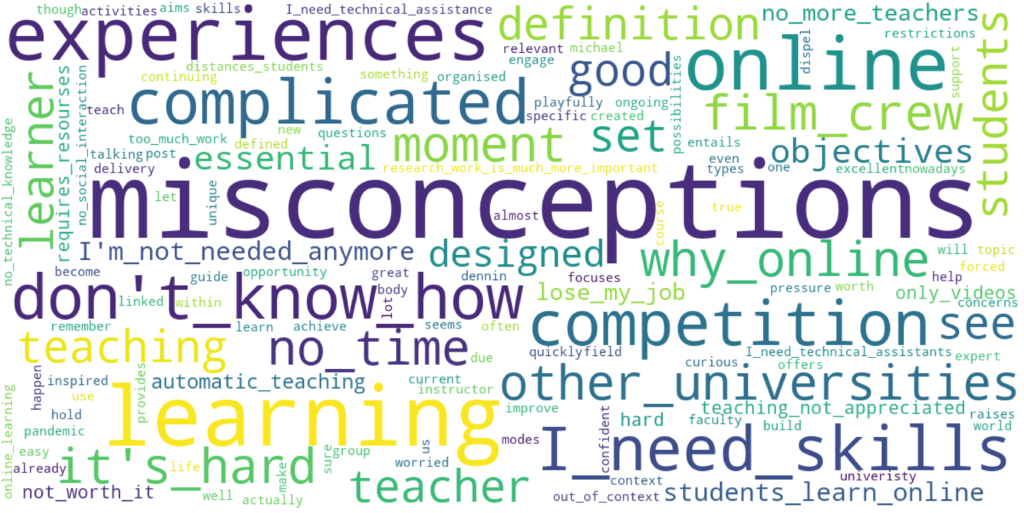Online learning is a topic that often raises questions on what this field actually entails. At the moment, almost all of us working in academia are forced to engage in online learning and teaching. Some are worried that with the current restrictions due to the ongoing pandemic, no good teaching or learning can happen. This does not have to be true! Online learning offers great possibilities for continuing to teach and learn while life seems to be on hold. Therefore, this is a good moment to dispel some of the misconceptions about online learning.
This post focuses on educators and aims to help them become more confident and playfully curious, as well as inspired to make use of this unique opportunity to build or improve their online teaching skills. Sure, learning something new under pressure is not easy, but you will see that it is worth it.
Before talking about online learning, let’s quickly remember what a course is. Michael Dennin from the University of Edinburgh provides an excellent definition:
A course is “an organised body of experiences created by an expert, the instructor, faculty or teacher, to guide a learner or a group of learners, the students, through a set of activities designed to achieve a set of learning objectives.”
As you can see, within this definition no specific modes of delivery (online learning is one of them) or types of experiences are defined. It is not essential. Essential is that the designed learning experiences support the learning objectives, and most of all, that they are relevant to the students’ concerns and context. And nowadays, a lot of that is linked to the online world already.

Now let’s look at some of the main misconceptions that we keep encountering. (For the purpose of not reinforcing the misconceptions, we have phrased statements that already dispel them.)
Online learning tools & technology do not replace the need for pedagogically sound course design.
This course design includes proper learning objectives, engaging, relevant and meaningful activities and interactions, and an overall memorable course & learning experience. Which currently available online tools could possibly take over the design of all of this? Educators sometimes fear that online learning means that they won’t be needed anymore, but as you can see, this is not the case. Even in MOOCs (Massive Open Online Course) educators still create and adjust course content, deliver some of it, and connect to students via course forums. Usually, utilising online learning (elements) provides the students with a greater and more relevant learning experience, if done in a useful and coherent way. And after a first learning curve, educators can find themselves being more free and creative in designing and delivering their courses in ways that they couldn’t before. It’s a win win.
You do not have to be in front of the camera to do online teaching.
Teaching online does not mean that you have to video record yourself (or your lectures). In fact, recording long lectures is not an effective way at all. While you can still do it, of course, there are plenty of other ways to teach online. For example, you can provide external materials and resources to your students to work on independently, which can be videos, text, audio (podcasts), interactive simulations or even games. This variety of media formats provides something for every learner’s preference and context, and there is a lot of quality and open-source material online these days. During class or an online session, the focus can then be on discussing the things that moved the students and answering questions. Giving them time to work with the materials at their own pace and then encouraging discussions or alike, will benefit the students much more than listening to someone talk.
If you still want or need to record yourself or a lecture, there are good ways to do that even without the need of a large film crew and in more interactive and fun ways (for you and for your students!). For example, take a look at our introduction to online learning video production.
Online learning does not replace social interaction.
Allowing students to study materials independently before or after a (online) classroom session allows them to study at their own pace. However, no matter if the course is fully online or blended (partly online, partly offline), there should always be a possibility for students to interact with the teaching staff and their peers. If one is restricted to online learning and remote instruction only, as is currently the case, this can happen in many ways still. For example, chat and breakout rooms in live sessions (e.g. via Zoom), independent group work (via Zoom or Microsoft Teams), forum discussions (on MyCourses) or virtual office hours (Zoom). See more about this also here, how to make Zoom sessions interactive.
Utilising online learning can ease your workload in the long run.
After a steep learning curve, creating blended learning or fully online learning can free up time for you in the long run. For example, especially if your courses have a high number of students and the topic allows for it, automatic assessment can be a life saver. It does take time to set up, but you will benefit from it for a long time. Also, if you move away from long lectures or the idea of creating numerous “talking” videos, and instead move towards your students studying materials independently or establishing peer-reviews and similar other activities, you might find that it makes learning more interesting for your students and teaching more effective and pleasant for yourself.
You don’t need to be a (tech) expert.
Online learning technology can be intimidating, yes. But, avoiding it might not be the best strategy. You cannot run from it forever, as it surely is the trend, now more than ever. Why not dive into it now and enjoy your skills in the future? Our Aalto community offers a lot of help when it comes to learning how to use special online tools. Face-to-face training, online tutorials or asking colleagues in your department, there are ways and people will be happy to guide you. If you are interested in creating videos or utilising virtual reality (VR) or augmented reality (AR), even for that you don’t have to be an expert to get started (just remember to not use these tools for the tools’ sake). For example, you can use existing and rather easy-to use studio setups at Aalto, or open-source 3D models for your VR ideas, etc. Or even better, do reach out and collaborate with experts! Remember also that you and your courses do not have to be perfect from the start. Tell your students that you are working to improve the course for them and they will be happy to work and develop it with you.
Start with blended learning. Use the advantages of offline & online elements for your specific teaching content and context.
When you can, implement online teaching and online learning elements step by step into your course and see what works. (Of course currently we are forced to dive right in). As mentioned in the beginning, implementing the planned activities online or offline does not matter per se, what matters more is that the delivery mode fits the learning content, context and the students and their concerns. Depending on what you are teaching (how you teach programming will differ from how you will want to teach design) and to whom (for example full-time students might be able to come to class, but students who work on the side may need more flexibility), you may want to use different blends of online and offline learning and teaching, as it makes sense. For some ideas, listen to our 15 min podcast about asynchronous vs. synchronous teaching. Finally, blending different approaches to create a fruitful learning experience will surely be appreciated by your students (and you eventually).
No, you are not the only or first one doing it!
Our Aalto community is huge. Often schools and departments work in silos and being up to date about everyone’s doings everywhere is impossible. But, that is where Aalto Online Learning comes in. We have pilots, connections and experiences with all Aalto schools and with most of the educational online tools and technology that you consider working with, or utilising in your courses. For example, take a look at the variety of online teaching and learning that is already ongoing at Aalto.
For this reason, if you don’t know where to start with blended or online learning, or videos, VR, AR or alike, ask us for help! 🙂 We will be able to point you in the right direction.
Have you come across other misconceptions that are not covered in this post? Please share them with us, together with any other thoughts or comments you might have on this topic. Let’s make (online) teaching and learning at Aalto easier, more fun and future-proof for everyone!
Authors: Sara Gottschalk and Tomi Kauppinen
A big thank you to Maria Lindqvist for the word cloud

